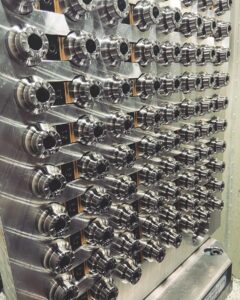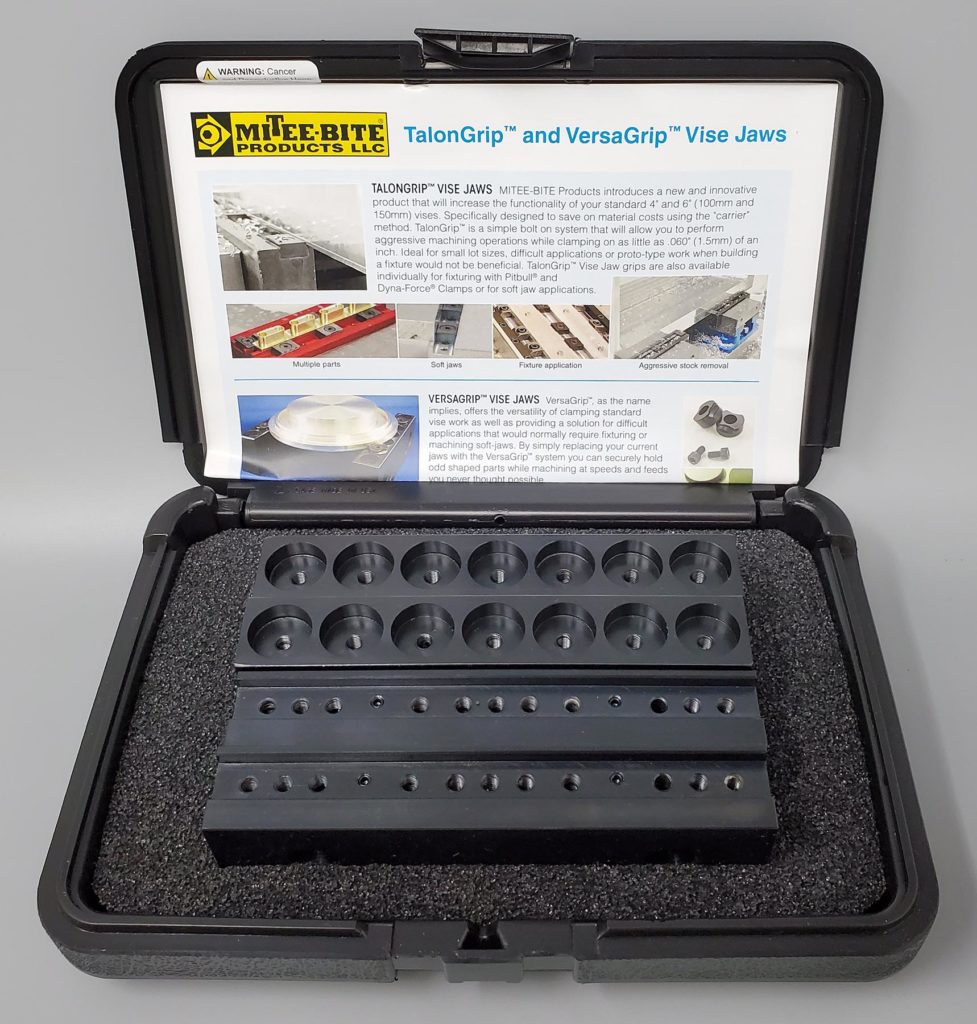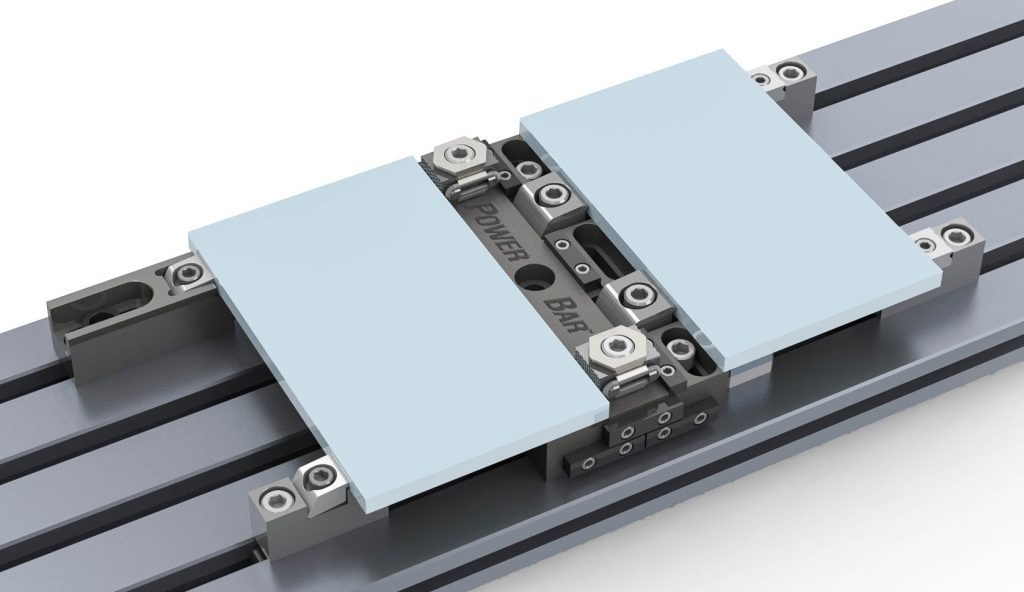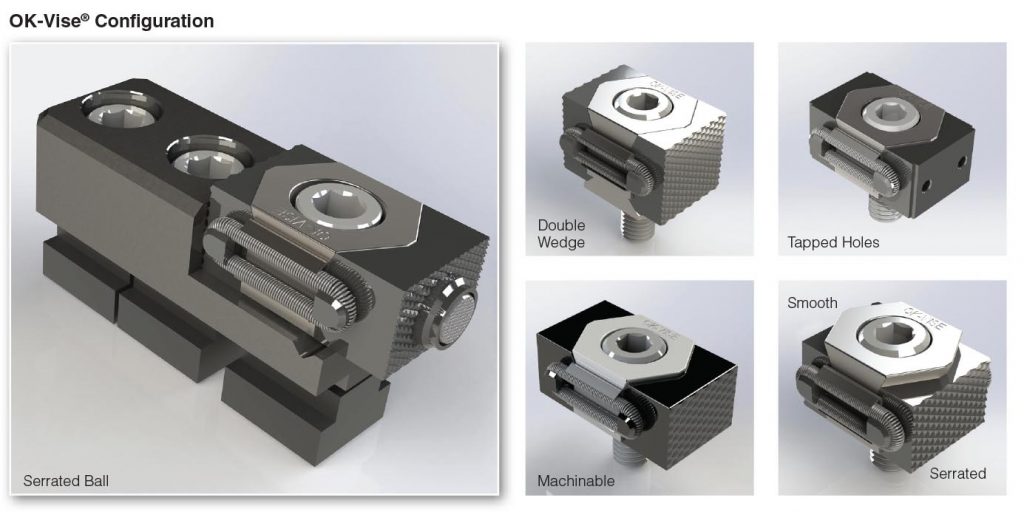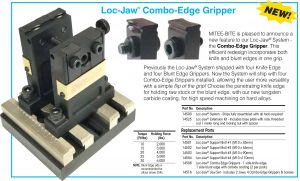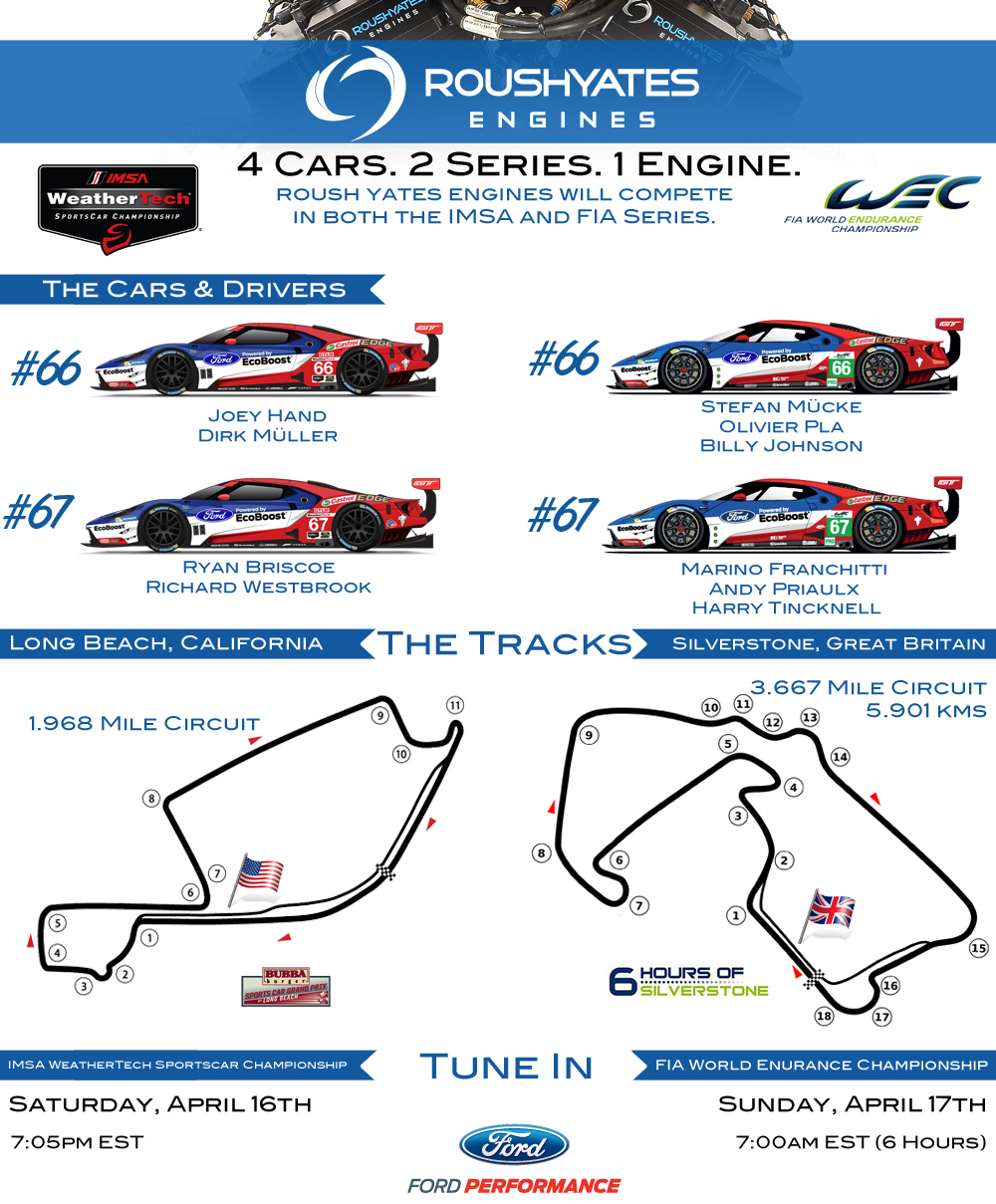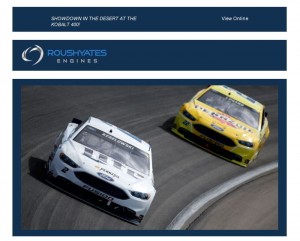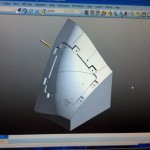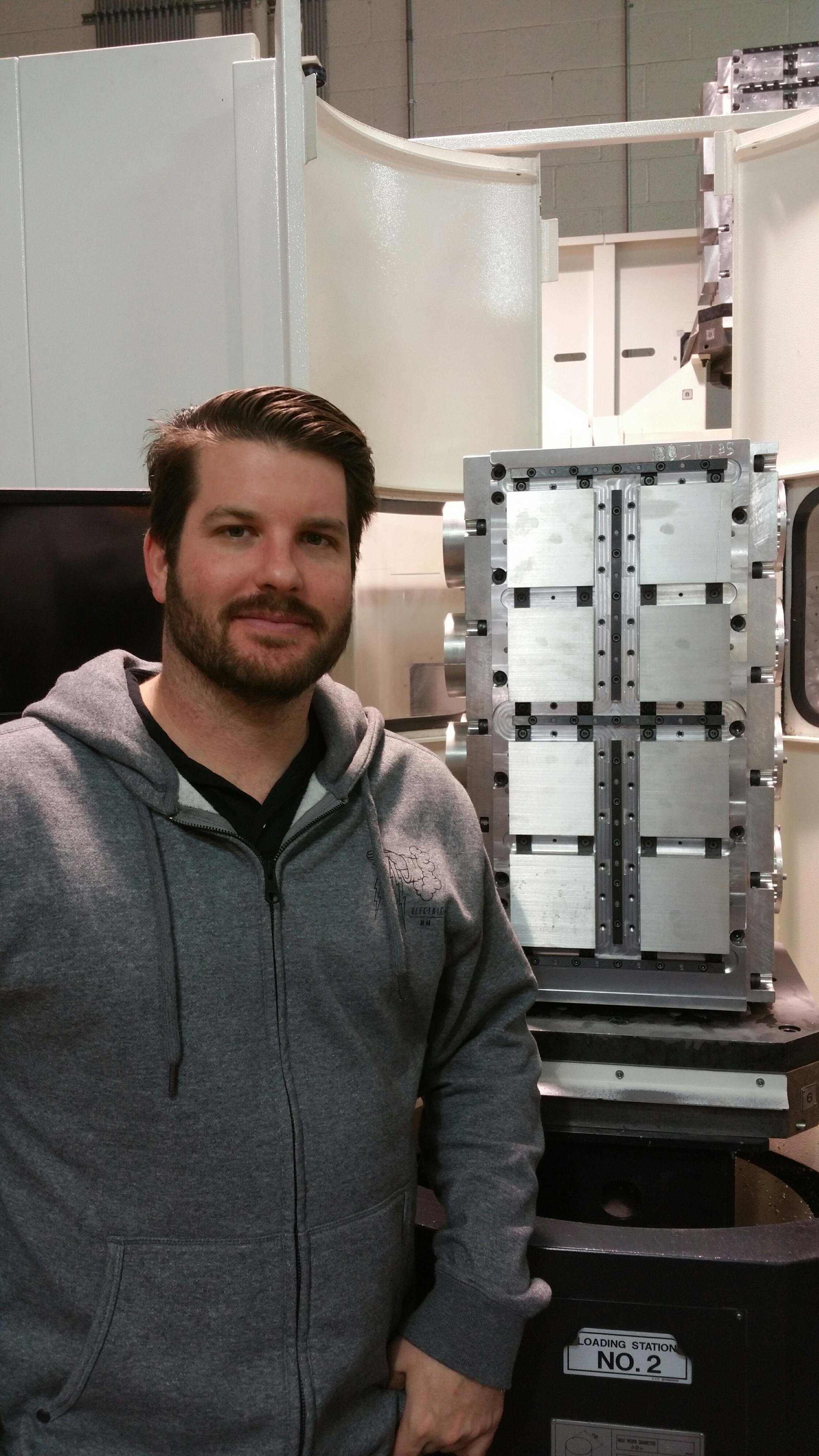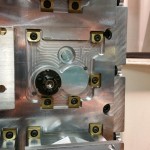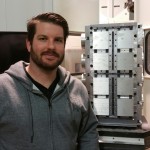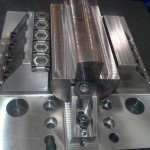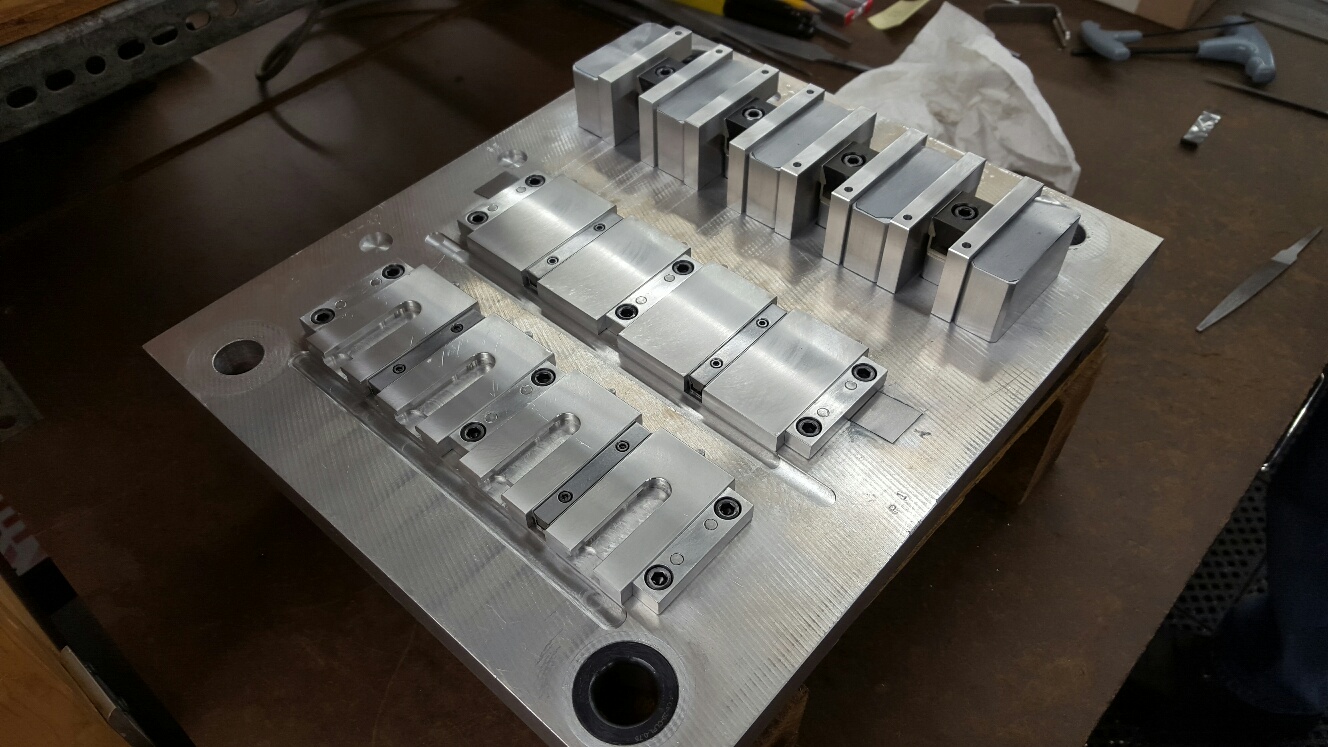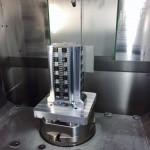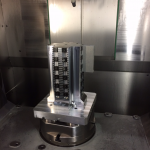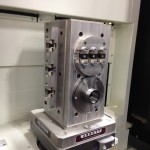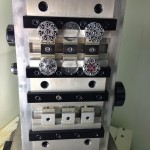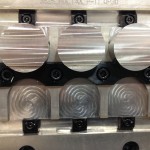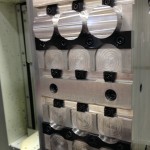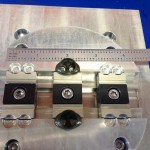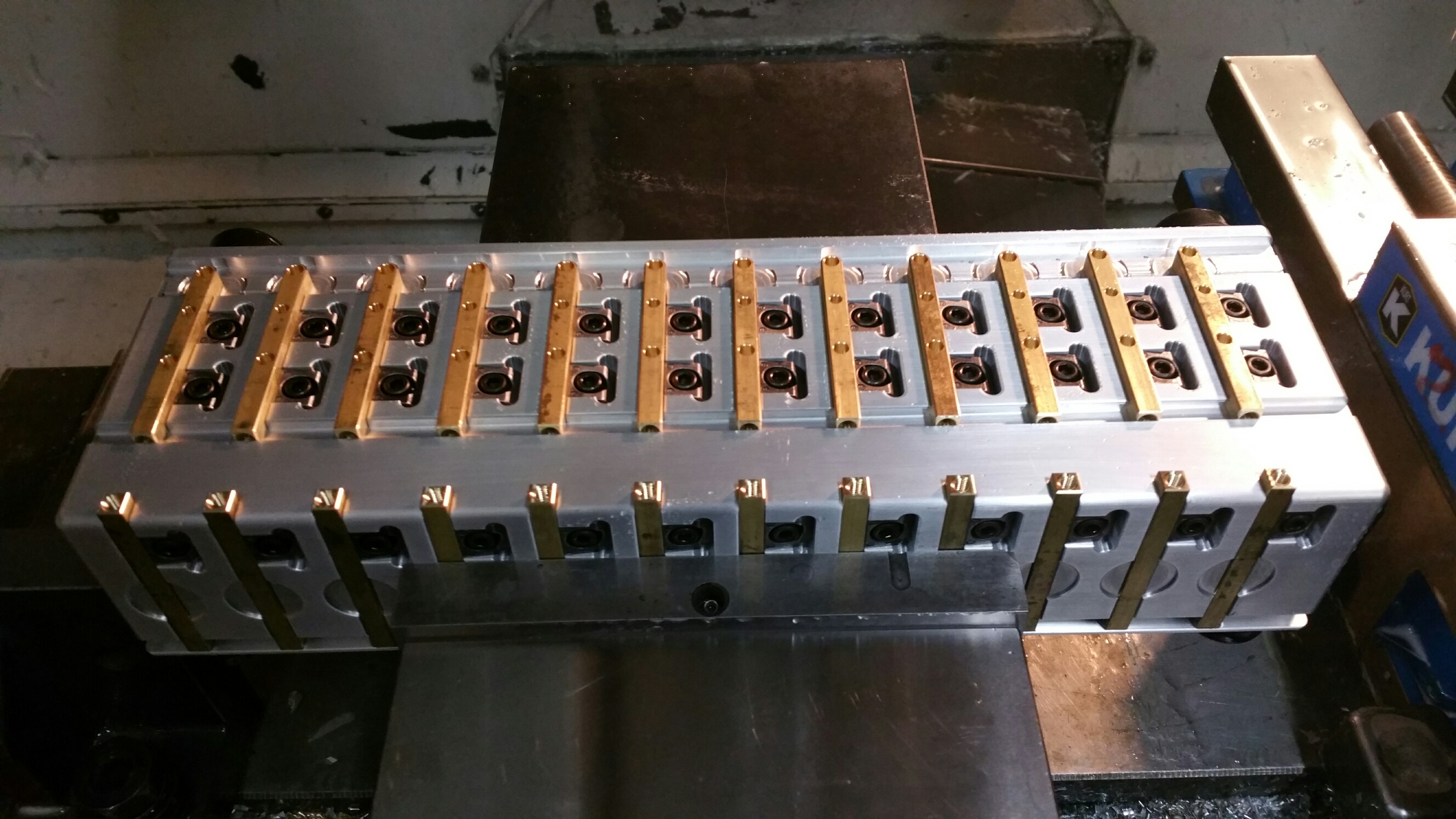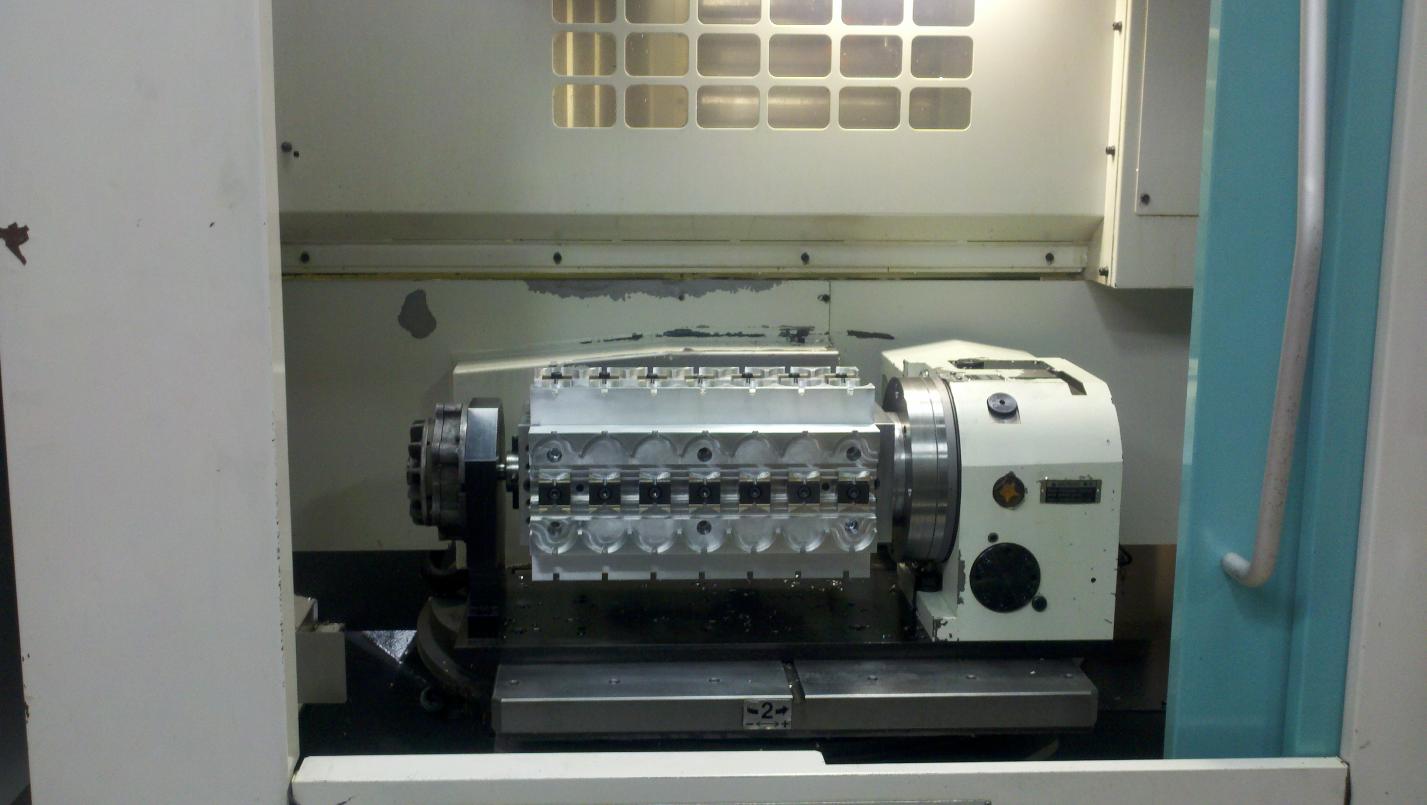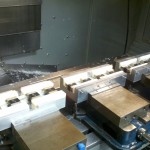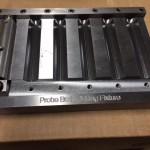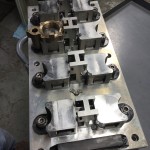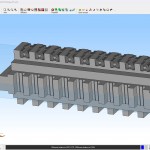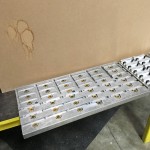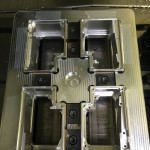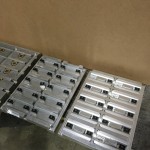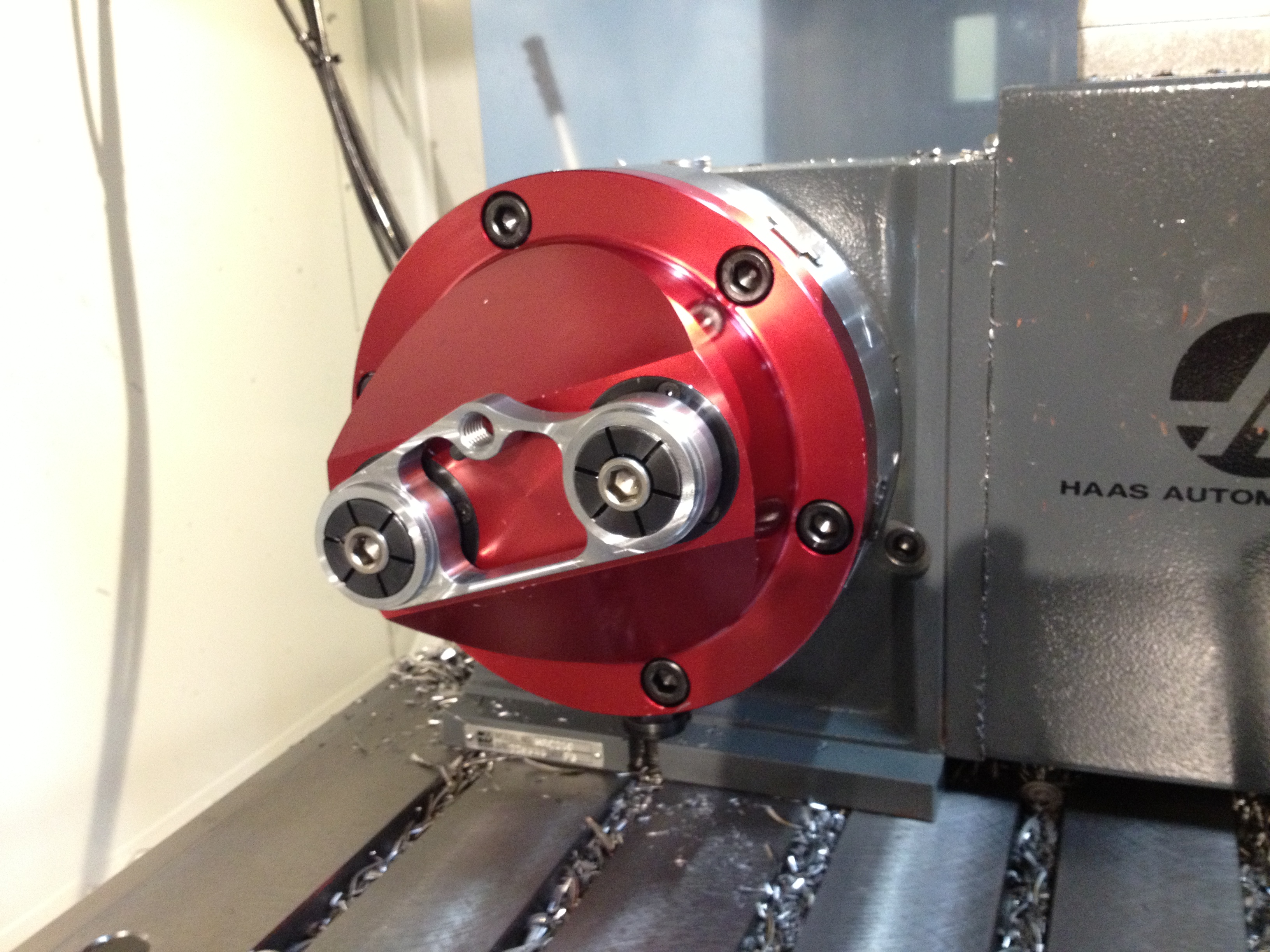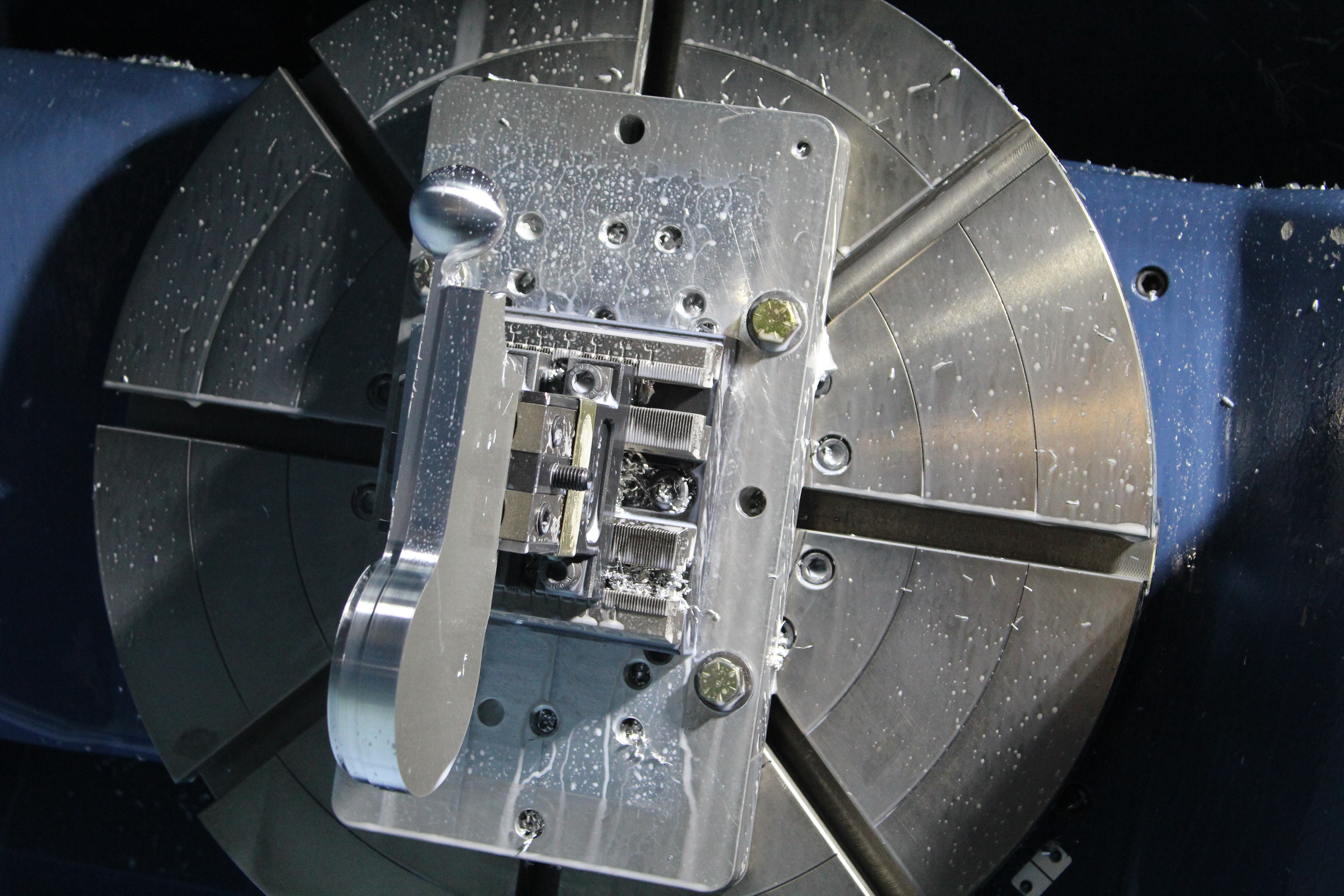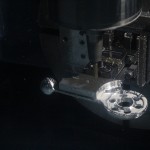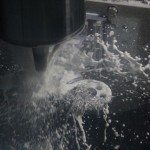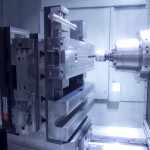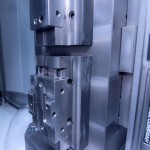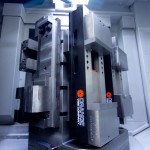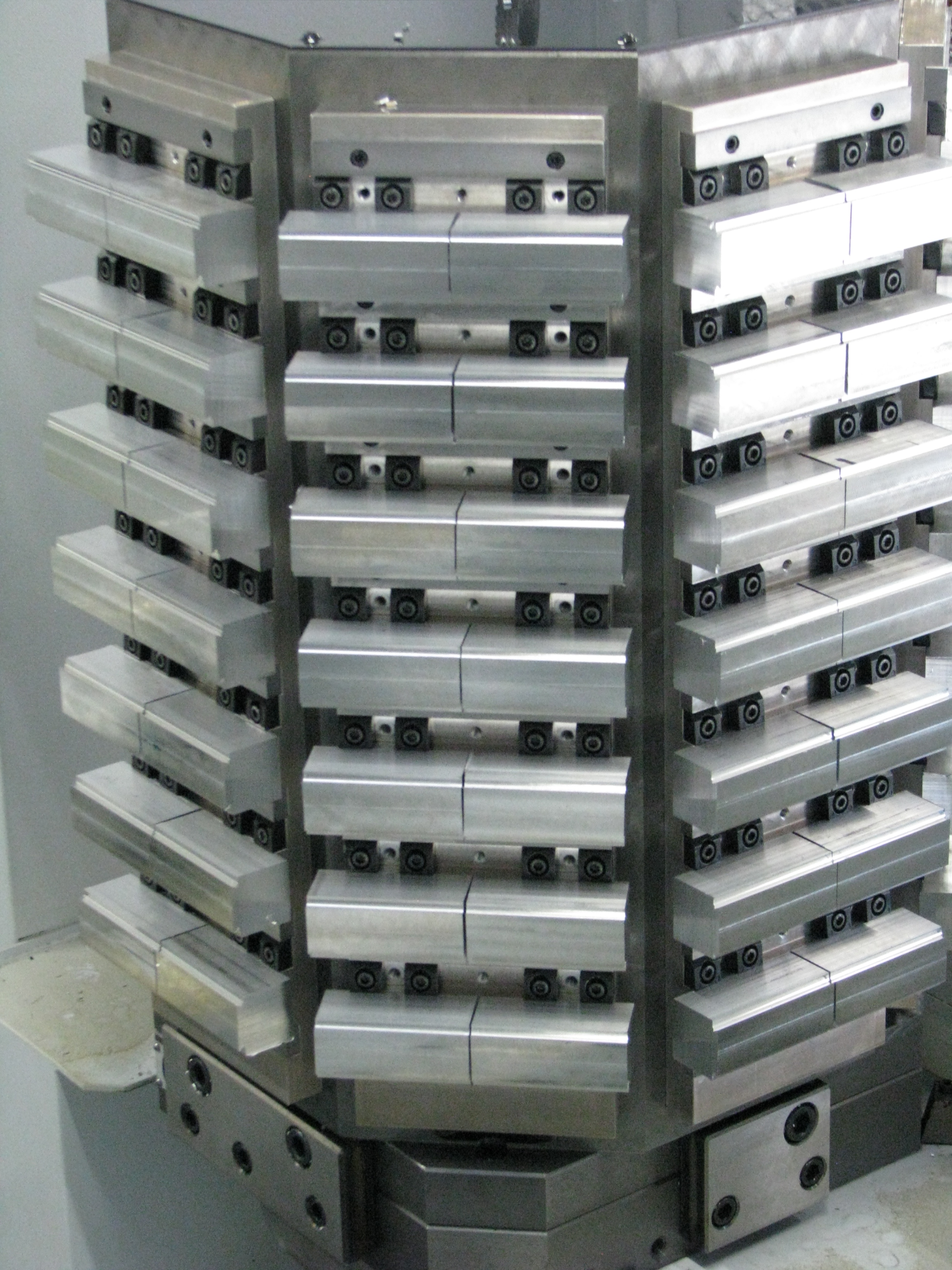Category Archives: News
Fill up with High-Density Workholding
High-Density Workholding Offers Many Benefits
High-density workholding offers many benefits, a prime one being the ability to run a machine tool longer unattended. Click here to read more!
New “Knurly” Collet Wrench!
Our supplier for the plastic red handles used on the original collet wrench, unfortunately went out of business – fortunately this provided an opportunity to produce a better product! Now with an aluminum, knurled handle for improved grip and includes a cross-hole when additional torque is required, by simply inserting screwdriver to tighten or loosen collets.
The MITEE-BITE Collet Wrench simplifies insertion and removal of collets in the spindle nose on CNC lathes and is available for 5C (PN1005C), 16C (PN1016C) and 3J (PN1003J) collets.
Low Temperature Wax Workholding Solution
NEW HEAVY DUTY VERSAGRIP!
Mitee-Bite Products introduces the NEW Heavy-Duty TalonGrip™ grippers!
Designed for those aggressive operations on harder materials while providing the ability to hold about any shape you can imagine – that’s the Mitee-Bite Grip! Standard gripping height or elevated for cutter clearance by resting part on the Original VersaGrip™ gripper or custom made pucks in the Versa pockets.
SHOT Show 2020 Raffle Winner Announced!
Mitee-Bite Products in Center Ossipee, NH would like to congratulate Russ Hegarty as the winner of a Talongrip™/Versagrip ViseJaw 6” Combo Kit given away at the SHOT Show in Las Vegas NV, January 20-21.
Russ is the owner of JT Arms in Prescott, AZ. They buy, sell and trade new and used firearms, provide full-service gunsmithing as well as CCW training. You can contact them through Facebook for more information.
We appreciate everyone who stopped by our booth and we look forward to seeing you all next year!
Roush Yates Partnership Extension with Mitee-Bite Products
Dealer, Rep and Manufacturer Work Together to Help Gardena, CA Company
Mitee-Bite Introduces The Power Bar™
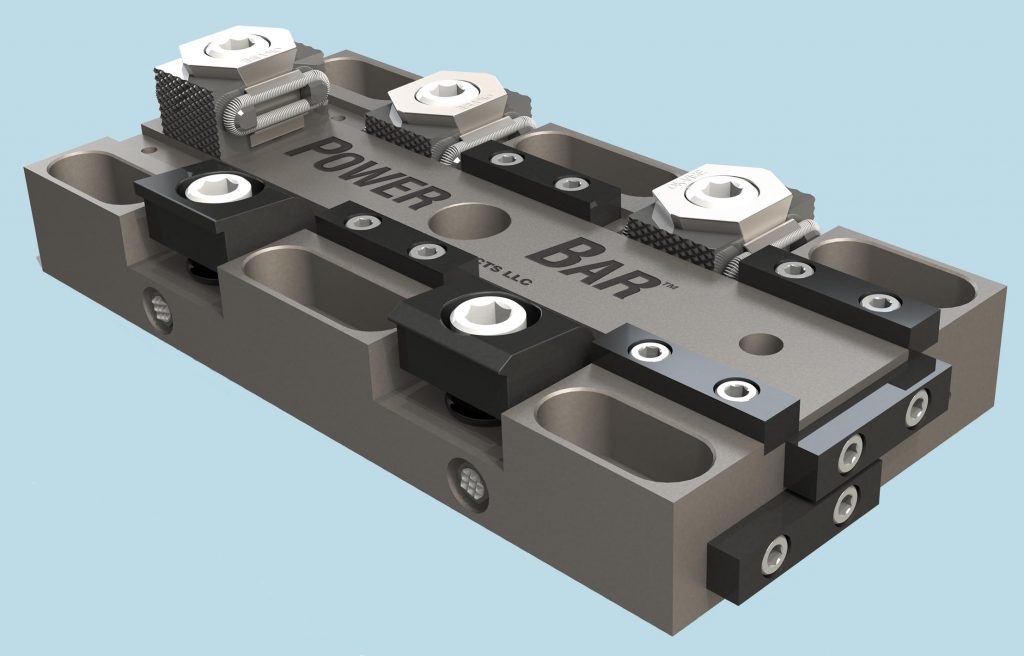 Mitee-Bite Products introduces the Power Bar™ – a modular platform designed to elevate your capabilities with some of the strongest clamps in today’s market. Utilizing any of the DK model OK-Vise® Wedge Clamps or our largest Pitbull® Clamps, you have the options to elevate your workpiece for mill/drill through operations or forcing your parts onto the machine table. Limit yourself to tooling and machine function, not your workholding!
Mitee-Bite Products introduces the Power Bar™ – a modular platform designed to elevate your capabilities with some of the strongest clamps in today’s market. Utilizing any of the DK model OK-Vise® Wedge Clamps or our largest Pitbull® Clamps, you have the options to elevate your workpiece for mill/drill through operations or forcing your parts onto the machine table. Limit yourself to tooling and machine function, not your workholding!
Features and benefits:
- Power Bar™ is precisely ground to the same height as our Modular In-line Clamps and Stops, Modular Pitbull® and Multi-Fixture Clamps and Stops for added versatility.
- Ideal for running in series for large aerospace and automotive application
- Can be used opposing each other for the most demanding operations
More Product Information and Pricing Available Soon!
Mitee-Bite Introduces the Heavy Duty™ T-Slot Clamp
Mitee-Bite Products introduces the Heavy Duty™ T-Slot Clamps – capable of generating over 20,000 pounds of pressure. This design utilizes some of the strongest lowest-profile clamps in the industry. The Pitbull® and OK-Vise® Clamps can be used on the same base with so many configurations you’re sure to have more holding force than needed!
‘TITANS of CNC Academy’ Kits now available!


The “Titan – American Built” series, first aired in 2014, featured episodes dedicated to showing CNC shops the best way to maximize their production with modern machining practices and is still airing on MAVTV today. Titan Ty Gilroy recently created a new and innovative platform, which is now accessible through the TITANS of CNC Academy website and provides free courses as well as the experience of thousands of talented machinists. Having great CNC instructors and open minded machinists teaching the next generation of makers to improve processes is a vision that already has a solid foundation and will lead shops to expand, hire more and at higher rates of pay. This Academy is the biggest free CNC manufacturing educational program ever developed with 1000s of projects, how-to and inspirational videos, and past episodes available on line.
Mitee-Bite Products has just completed a new Kit for the TITANS of CNC Academy, helping to educate in the Art of Fixturing Series. In the kit students will receive multiple Mitee-Bite clamps, pins and grips to build Titan’s Project Series #400-404 fixtures. “TITANS of CNC Kit” (Part no. 30400) may be purchased through local Mitee-Bite Distributors.
To learn more and sign up for the Free TITANS of CNC Academy, visit Academy.TITANSofCNC.com.
XYZ Press Fit Pins now available in 12L14
NEW LOC-JAW COMBO-EDGE GRIPPERS
FIFTY YEARS IN THE MAKING FORD WINS POLE AND LM GTE PRO CLASS AT LE MANS!
FIFTY YEARS IN THE MAKING FORD WINS POLE AND LM GTE PRO CLASS AT LE MANS!
LE MANS, France, JUNE 19, 2016 –History has been made! The No. 68 (Joey Hand (US), Dirk Müller (GER), and Sébastien Bourdais (FRA)) wins the 84th running of the 24 Hours of Le Mans. Fifty years after Ford’s legendary 1966 victory, the twin-turbo Ford EcoBoost V6 race engine and Ford Chip Ganassi No. 68 car performed flawlessly during the 24 hour endurance race. Roush Yates Engines working in partnership with Ford Performance powered the Ford Chip Ganassi Racing team to a legendary victory (la victoire) at the iconic Circuit de la Sarthe in Le Mans, France.
Roush Yates Engines. 4 cars. 2 series. 1 engine!
We are counting down to the start of the 2016 FIA World Endurance Championship season in Silverstone, Great Britain. Where the Ford GTs will make their official overseas race debut on April 17th. During this same weekend the IMSA series will take over the streets of Long Beach, CA to run the third WeatherTech Sportscar Championship race of the season.
This is only possible because of strategic partners like Mitee-Bite. We rely on your dedicated team and premium clamps every day to achieve our goal of building world class engines.
Roush Yates Engines is proud to be the exclusive manufacturer of the twin turbo Ford EcoBoost V6 race engine that will power the Ford GT “Super Car,” as referred to by Dave Pericak, Global Director, Ford Performance.
The twin turbo Ford EcoBoost V6 will power a four car team this weekend, which will span across two continents for Ford Chip Ganassi Racing in pursuit of victory lane.
The 6 Hours of Silverstone kicks off the 2016 World Endurance Championship (WEC) season from the UK. The WEC is a global road racing world championship, organized by the Automobile Club de l’Ouest (ACO) and sanctioned by the Fédération Internationale de l’Automobile (FIA). The series will travel across three (3) continents, covering nine (9) different countries and run at nine (9) unique circuits, including the world renowned Le Mans, France. The endurance races are all six (6) hours in length, except for the historic 24 Hours of Le Mans.
Roush Yates Engines designs, develops and builds three distinctive race engines.
• Twin-turbo Ford EcoBoost V6 engine for the IMSA WeatherTech Sportscar Championship (North America) and FIA World Endurance Championship (global)
• 5.2L Ford V8 for the IMSA Continental Tire SportsCar Challenge
• FR9 Ford V8 engine for the NASCAR series
Since 2004, Roush Yates Engines has achieved over 255 combined wins in the IMSA and NASCAR series. In 2016, we will supply the power for 114 races and provide team support to 14 NASCAR, four (4) IMSA and two (2) FIA premier teams.
We invite you, your team and partners to join us and follow the exciting sport of racing on Roush Yates Facebook and/or on Twitter @roushyates.
4 CARS. 2 SERIES. 1 ROUSH YATES ENGINE!
SHOWDOWN IN THE DESERT AT THE KOBALT 400!
Las Vegas, Nev. (March 7, 2016) – SHOWDOWN in Vegas, delivers a 1 – 2 punch and the first win of the season for Team Penske, Ford Performance, and Roush Yates Engines! As the exclusive engine builder for Ford Performance teams, Roush Yates Engines’ powered Brad Keselowski No. 2 to victory lane at the Kobalt 400.
Brad Keselowski No. 2 and Joey Logano No. 22, in the new Ford Fusions battled throughout the day. “Bad Brad” overcame the elements – wind (at 45 mph), rain, sun, sandstorm, pit road speeding penalty, tire and fuel gamble, and it all came down to a showdown in the final laps. With 9 laps to go, Keselowski passed teammate Logano for second and in the closing 6 laps was able to chase down Kyle Busch No. 18 to take the lead and to win the ultimate Las Vegas Jackpot. Logano showed his determination and battled to the very end, overtaking Busch on the last lap to deliver the Team Penske 1 – 2 punch. The Fords led a combined 99 laps in all and the Team Penske drivers showed they were focused for a win.
“This is really, really great,” said Brad Keselowski in victory lane. “It seemed like there were plenty of challenges, whether it was pit road or the weather or cautions. They threw everything they had at us today, but this Miller Lite Ford team was too strong and we were able to fight them off and get to victory lane.”
This started the West Coast swing off in dramatic fashion and delivered Team Penske their first win this season and their third 1 – 2 finish of all time. What a way to start off Team Penske’s 50th Anniversary year! As Brad referenced his boss, “effort equals results.”
“Winning the first leg of the West Coast swing, here in Las Vegas is a testament to our team’s passion and dedication to being the leader in engine development and collaboration with our great partners Ford Performance and Team Penske”, said Doug Yates, President and CEO of Roush Yates Engines.
Roush Yates Engines and Ford Performance engineering teams worked together to develop the optimal performance package for the Ford FR9 V8. Every element of the engine was optimized to contribute to the overall performance and fuel economy. Delivering Ford its 9th overall manufacturers win at Las Vegas Motor Speedway, dating back to the inaugural win in 1998 with Mark Martin, is a testament to their culture of winning.
In 2016, Roush Yates Engines will build engines for 114 races, spanning across 5 premium race series, and covering 9 different countries. This would not be possible without strong partnerships. The accomplishments of Roush Yates Engines on and off the track are the direct result of relationships with great partners like Ford Performance, Mahle Clevite, Cometic Gasket, Universal Technical Institute, Mitsubishi Materials U.S.A., Safety Kleen, Rottler Manufacturing, Mastercam and Mitee-Bite. Roush Yates Engines relies on these products and services every week, as they play a vital role in their continued success.
For more information visit http://www.roushyates.com Like Roush Yates Engines on Facebook, follow Roush Yates Engines on Twitter @roushyates and subscribe to our YouTube channel RoushYates.
Our partner Roush Yates Engines is ready to “start their engines” on this season!
The Daytona 500 is here! The Great American Race!
Roush Yates Engines is very excited about kicking off the 2016 NASCAR race season.
Roush Yates Engines is the exclusive engine manufacturer of the Ford FR9 V8 engine; that will power the Ford Performance NASCAR vehicles.
We will support a combined 17 NASCAR Sprint Cup, Xfinity and Camping World Truck Series (CWTS) race teams during the 2016 season.
Over the next 40 weeks more than 1,000 engines will be built to participate in excess of 90 races and we are so proud to be doing this with first class products and technical assistance from Mitee-Bite.
It is stacking up to be an exciting week with a lot of activities starting Thursday, February 18th with the Can-Am Duel qualifying races.
We invite you to follow Roush Yates on Facebook and/or on Twitter @roushyates throughout the week and weekend to see some behind the scenes activities and support the teams.
There will be a lot of special surprises throughout the week. Come join the fun!
Here is a quick look at this week’s activities.
NASCAR Sprint Cup Series Can-Am Duel Qualifying races (60 Laps, 150 Miles)
Can-AM Duel #1
Race Day: Thursday, February 18, 2016
Time: 7:00 PM ET
Can-Am Duel #2
Time: 9:00 PM ET
NASCAR Camp World Truck Series NextEra Energy Resources 250 (100 Laps, 250 Miles)
Race Day: Friday, February 19, 2016
Time: 7:30 PM ET
NASCAR Xfinity Series PowerShares QQQ 300 (120 Laps, 300 Miles)
Race Day: Saturday, February 20, 2016
Time: 3:30 PM ET
NASCAR Sprint Cup Series Daytona 500 (200 Laps, 500 Miles)
Race Day: Sunday, February 21, 2016
Time: 1:00 PM ET
Please see attached Ford Performance driver announcement pages for a complete listing of teams and drivers.
Todd English
Roush Yates Engines
TOP DOG CONTEST WINNER: Darren King, FFWD Connection
Top Dog 1st Runner-Up: Tim Friedmann, Triangle Precision Industries
This fixture for a contour part nested inside a contoured pocket and clamped with Pitbull clamps around outside of part to finish the thickness that followed the contour. For a size reference, I started with a 11″ X 11″ x 9″ block to make his fixture. The setup is mounted on a trunion in a 5 axis Hurco as all the holes were on compound angles staying perpendicular to the contour.
The part is a support strut for a fighter aircraft manufactured for a aerospace company.
”I can’t show you the part that fits in this fixture, “but I can say the Pitbull clamps saved me tons of trouble making this part!”
Top Dog 2nd Runner Up: Robert Pelzer, Cassavant Machining, Inc.
We at Cassavant machining employ numerous Mitee-Bite technologies on a fixtures on nearly 50% of our machining setups for 3, 4 and 5 axis mill machining centers. Too many to count!
I chose a job from our horizontal machining cell to submit.
We were able to complete 95% of the of the part features.
Op 1, we utilize the versa grips and Pitbull clamps.
Op 2, we make use of the expandable clamps and brass Pitbull’s.
Top Dog Entry: Artur Dzhyoyev, CFN Precision
Top Dog Entry: Jon C. Baker, Bag Parts International Corp.
I needed a simple fixture that would locate on a ramped surface to hold parts in place for surface grinding. I talked with Tim Krafton in the engineering department at mitee-Bite a few times during this design and he gave me pointers since I had never used the uniforce clamps before. When finished, I was quite pleased with the results and the owner at the grinding shop said it was one of the best grinding fixtures he has ever used. The best part was his price, it was so simple and fast to change out parts, that the grinding cost from him was lower than just my wage to grind them in house one at a time. Thanks for all your help and the great downloadable CAD files that make design so much easier.
Top Dog Entry: Joel Smith, Westboro Machine Co.
The initial purchase order for this job was 200 pieces per year which consisted of milling the 4-operation piece one at a time. When the customer increased their order to 2000 per year, we needed a more efficient way to do this job. Being a small job shop, we could not afford to have a machine tied up for long periods of time. Our solution was to configure a plate that would hold 16 pieces in total with 4 pieces coming off complete per program run. The next step was to ensure the machine was running consistently so we configured a second plate so that the spindle is running almost continually. The clamping solution also allowed us to program the machine to do all the deburring and polishing on the plate that was done initially by hand. Thanks to the Miteebite clamps we were able to cut down on production time and produce a higher quality, consistent looking part.
Top Dog Entry: Dennis van Kessel, CNC Solution
Top Dog Entry: Chuck Hall, AFCO Industries
Since all AFCO products start out as aluminum extrusion we are faced with small parts, with thin wall but need to produce high volumes. For the 13 years I have been with AFCO we have used several types of Mitee-Bite clamps to build fixtures and they always perform great.
The 61500 clamps hold the parts secure allowing for high feed rates, cut depths and repeatability. These fixture are used in a CNC with pallet changer and we tighten the parts using a 12 volt lightweight cordless drill. Machines 32 parts per each pallet. Thanks.
- Old set-up
Top Dog Entry: Mitch Niemela, Toolcraft Inc.
When looking at workholding for these parts, we knew we needed something more compact than a typical vise. We looked into everything from completely custom manufacturing a solution in-house, to having a completely custom solution manufactured for us. We did not have the resources to start completely from scratch, but we did want to have a hand in designing the fixtures so that we could easily adapt as the project progressed. The Mitee-Bite clamps fit what we were searching for exactly. We downloaded the Machinable Uniforce clamp solid models that we selected, dropped them into plates we designed in-house, and were able to quickly and easily come up with a complete set of fixtures for this family of parts. Machining the fixtures was simple; the instructions for setting the fixtures properly were easy to follow and worked right the first time. Clamping performance is great as well, which is important with the aggressive toolpaths we applied to the parts.
Since the first fixture for this family of parts was successfully implemented, we made fixtures that used Pitbull, regular Uniforce and ID Expansion clamps. Every time we implemented a Mitee-Bite component, the process was simple and pain-free. The components are affordable and in-stock. They are very well supported if anything comes up. There are many reasons why we have chosen to use Mitee-Bite components and will continue to do so.
We came across an interesting challenge with a shorter-run production Fitting for the Aerospace industry. This part is 7075-T651 and the geometry is pretty simple. The order was for about 100 parts. The challenging feature is a Ø.6875-.6880 bore thru one end. When using a typical flat jaw/parallel or step jaws setup, the part needs to be squeezed very tight in order for the part not to come out of the vise. When flat jaws are used, the bore tolerance cannot be held near in tolerance, because the part is bored under stress, then releases after unclamping resulting in an out-of-round condition.
With the TalonGrip jaws, we clamp on tablesawn material blanks (no need to square-up), clamp to approx. 200in./lbs, unclamp, then re-clamp to 70in./lbs. The overclamp/re-clamp method makes little indentations in the material that allow the part to be final clamped under much lower stress but still retain enough holding power not to come loose during rouging. This part would get a custom fixture if it were to go into higher production, but TalonGrip jaws allowed Toolcraft to easily machine these critical parts in-spec without making a custom fixture for this lower production run.
Top Dog Entry: Miguel Ruiz, J/E Bearing & Machine LTD
These are the pictures of the fixture , we use it to machine bars and blocks , we hold different sizes , from 11 feet bars to 2” blocks we do machining around the parts, chamfers and threaded holes , we drill and tap 800 holes per set up , quantity of parts from 6 long square bars to 197 small blocks, I can not take pictures of the parts for now because is government job. The clamps work great allow us to save space in the fixture because it hold to parts , great holding force too.,
Let me know what else do you need .
Top Dog Entry: Mark Wisniewski, East Coast Automation
1, fixture holds 24 parts 12 in the vertical and 12 horizontally
2, The parts on the front (vertical ) are recessed .010 in. This face is also the datum of the fixture and clamped against the fixed jaw of the vise.
3, The parts on top of the fixture stick up .125 in. This allows for machining a chamfer all around the top edge.
4. The locating surface on the bottom front edge and is also relived. 1/32 of an inch to allow for the burr from cutoff to clear the locating surface. This saved pre-deburring before loading into the fixture.
5, The top face also has relief for the cutoff burr.
6, The spacing is 1 in. And the top and face slots are lined up. This makes arraying easy.
7, I have rubber feet on both the bottom and back face. They are spread out to the ends of the fixture and don’t interfere with clamping into the vise.
8. The other benefit of having the rubber feet is it keeps the 2 reference surfaces off the bench will loading and transferring parts. It is also easy to pick up.
9. All edges are radiuses. They help keep dings from our in handling. They also feel good when handling.
10, The front surface has 12 spot faces they are .03 deep and when loading the parts allows you to push down on the surface of the part to make sure they are fully home.
11, I used a Milwaukee 2402-20 fuel set at 9 to tighten the clamps.
12 The fixtures are made from 6061 aluminum. So I used E-Z LOCK 329-008 steel inserts for 8-32 screws.These I set as close to flush to the bottom of the Pitt bull Clamp pockets as I could.
13. I added an additional oring to help lift the clamps out of the way for loading.
14. There were only 7 tool changes needed for each load. The old way would have been 108 tool changes.
15 The parts took 75 sec ea. Including swapping fixtures.
The savings in time wear and tear on the tool changer are great. The other nice thing about spreading out the parts is the machine wear on the ways is also distributed.
I highly recommend the pit bull clamps.
- Old fixture 2
- Old fixture
Top Dog Entry: Dan Boisvert, Arro Engineering Corp
I have a whole bench full of your products.
Before I started using Mitee Bite products, We were only fixturing in softjaws. After I started to implement Mitee Bite, I have seen a time reduction of over 300% in a couple of the parts we manufacture. In one instance we used to run one vice, with three parts being made in that vice. With a cycle time of 3:30.Now I am running 56 pcs on a tombstone with a total cycle time of 25:00.
Your products gave me new ideas on how to utilize our cnc machines!
Top Dog Entry: Curtis Reed, W.L. Walker Co.
Here is our latest fixture using your Pitbull clamps. The parts on the left side of the fixture get cut in half then transferred to the right side of the fixture to get a flat cut on top. These are brass cable clamps used in our digital thermometer probes. These parts are held at +.005 -.000 with ease. Our productivity of these parts was increased greatly by the speed and ease of use of these clamps. Thank you for a great product.
Top Dog Entry: Jez Pring, TWM Technology
I use your products frequently and I have never had any problems and they are so useful and easy to set up.
I will start telling you that initially the component I am talking about used to be done one side at a time using 3 different vices as shown in ‘original’ picture. The holes are fairly complex consisting of thread milled portion and a series of tied up counterbores to suit solder joints and fixings.Now this would take approximately 16 minutes per part with loading time which meant about 30 parts per day.So I designed and made a trunion fixture using your clamps and invested in a 4th axis and now the parts take approx 2.5 minutes each and 72 of these are loaded at a time. This meant there was enough time to get a 3rd batch running before the end of the day to run when lights out so we are now machining 216 parts a day. We made 4600 parts this year so you can see how massive a saving was made by doing it this way.
I hope this was of some interest as it is something i am quite proud of.
- Original
Top Dog Entry: Spartan Robotics FRC Team #971, Mountain View High School
I wanted to share what our First Robotics team, FRC Team #971 Spartan Robotics of Mountain View High School is doing with Mitee-Bite fixture clamps.
In 2014 several mentors and a few students set out to design and build a CNC router to help fabricate parts for the competition robots. The CNC router was completed in the spring of 2015 and immediately put into service fabricating parts for a student lead off-season project robot project.
A special fixture was made to hold aluminum square tube stock. Using Mitee-Bite fixture clamps and spacers the fixture will hold tubes from 1/2″ x 1/2″ up to 2′ x 2″.
Top Dog Entry 4 Mountain View High School |
Top Dog Entry: Mark Ames , Mainland Machine
The raw stock size is 16″ diameter x 4.15″ tall. The part weighs 83.4 lbs and we are holding it down with two ¼-20 Pitbull clamps pushing against a TalonGrip on the far side.
The parts machined perfectly without a single part moving on the fixture.
Even though we only had a total of 5 parts to make, using the Pitbull clamps and building a fixture plate was very cost effective, both because the Pitbull clamp is simple and easy to use and because it was very important that no parts came loose during the machining operation.
Top Dog Entry: Joel Smith, Westboro Machine Co.
The initial purchase order for this job was 200 pieces per year which consisted of milling the 4-operation piece one at a time. When the customer increased their order to 2000 per year, we needed a more efficient way to do this job. Being a small job shop, we could not afford to have a machine tied up for long periods of time. Our solution was to configure a plate that would hold 16 pieces in total with 4 pieces coming off complete per program run. The next step was to ensure the machine was running consistently so we configured a second plate so that the spindle is running almost continually. The clamping solution also allowed us to program the machine to do all the deburring and polishing on the plate that was done initially by hand. Thanks to the Mitee-Bite clamps we were able to cut down on production time and produce a higher quality, consistent looking part.
Top Dog Entry: Mark Emly, TyMar Tool Works
We inherited a couple of jobs and the fixtures. The old fixtures took up a lot of space on the table and wasted a lot of product. We changed the chamber fixture over to two pallets using mitee-bite uni-force clamps and with each run we now get 20 completed parts as opposed to 12. With a more compact set up my wife can easily set the pallets up to run on her own without any help from me. Our run time has gone from 4 ten hour days to 2 nine hour days finally making the job profitable.
For the box set up I made a compact aluminum pallet that the parts fit down into using mitee-bite uni-force clamps replacing a much larger pallet that used pneumatic cylinders. The old fixture put out 2 completed part each run and because of the size of the fixture and the unreliable clamping of the part, we were only able to get 7 to 8 parts per hour. The new pallet system puts out 2 completed parts and we can achieve 14 parts per hour. Also, with the compact system it fits into the vise and we have modified the vise so that the set up time is only a few minutes, versus an hour with the old fixture, and the vise set up allows an operator to change the set up instead of having a set up person do it.
I have also included a few pictures of set ups using the Mitee-Bite Talon grip jaws, one of the parts is showing an action shot of the milling the 420 prehardened stainless steel with a ½” cutter, 1.300” doc and .025” step over at 1050 IPM, these Talon grip jaws have been had the most ROI of any thing that I have ever purchased.
Thanks Mitee Bite for having products that help us reduce setup time and increase profits.
12/29/15 Holding Challenging Parts

Some workpieces, like those that are oddly shaped, large or delicate, can be a real pain in the neck. Delicate geometries, thin walls and shapes more flexible than a ballerina what’s the best way to securely grab hold of them? Gerard Vacio, workholding systems specialist at BIG Kaiser Precision Tooling Inc., Hoffman Estates, Ill., said the economics of machining these parts means spending more time and money up front to figure out the best way to fixture them. “Nobody wants to do that,” he said. “Designing and building the fixture often ends up eating all the profits from the job. That’s why a lot of shops turn down this kind of work. Unless you have some influence over part design, where you can add features or tweak geometry to make a part easier to hold, it’s often a losing proposition. Even companies that build their own products don’t always realize the possibilities of lobbying the engineering department to make parts more manufacturable.” Design for manufacturability aside, some companies thrive on making complex parts. Vacio said these shops use their creativity and engineering brilliance to find the most economical solution. “No one has yet invented a tractor beam that’s going to solve workholding problems. The result is that people end up tackling each element of a difficult workpiece individually.” Examples include sandbags placed on the part to reduce vibration, or the use of specialty glue or low-melt potting compound to support delicate areas during machining. Often, you can use part features, such as a threaded boss or dowel pin holes, to locate and clamp a part. “There’s no one solution. It’s a matter of utilizing whatever’s available,” Vacio said.
He recommends careful planning, because the first operation can make or break the ability to grip difficult-to-hold parts later on. This is one job 5-axis machining centers excel at, he explained. A part can be gripped once, when it has the most material available, then tipped and rotated until the machining is nearly completed. With the right strategy and a little luck, all that remains is refixturing the part and a quick saw cut or a slice with a wire EDM and the part drops off complete. Even without a 5-axis machine, this use of sacrificial material is a common practice with oddly shaped workpieces. David Bishop, general manager of workholding manufacturer Mitee-Bite Products LLC, Center Ossipee, N.H., said the carrier method is an easy solution for oddballs. “It’s a fun challenge to place as many parts as possible in the machining envelope and complete the part in two operations or less. Even an extra 1⁄16″ of material
on the bottom of the workpiece is often enough to hang on to. By gripping low, you can machine the top and sides, then nest the part in machinable jaws or a quick-change fixture of some kind to mill away the gripping surface and at the same time finish the workpiece.”
One excellent example of this is an aluminum landing gear component made by one of Mitee-Bite’s customers, Straightline Precision Industries Inc., Sidney, B.C. The part was machined nearly complete on a tilt-rotary table—all that remains is to grip the center section and remove the carrier. Another approach is locating on internal part features. A pair of adjacent holes makes a nifty place to grab a part, which is why Mitee-Bite and other workholding providers carry a range of expansion clamps and internal collets to grip a 3⁄16″ diameter or smaller. Bishop pointed out a recent example of this with Haas Automation, where a rotary table was used to machine the part in several operations, the final one locating off a pair of 1.375″-dia. bores.
Lastly, Bishop said don’t forget about air power. Vacuum chucks are a great way to secure large, flat workpieces. As proof, Mitee-Bite customer Fore Machine Co., Fort Worth, Texas, used six interconnected vacuum chucks together with an aluminum top plate to grip a pair of Ti6Al4V titanium deck plates used on Bell UH-1 Iroquois helicopters (the Huey), allowing it to machine the entire top surface in a single operation, without the need for toe clamps or clamping screws. If you have a difficult part and need help, don’t be afraid to ask. Many workholding providers offer consulting services, from free ideas and advice to complete turnkey solutions. One is Stace-Allen Chucks Inc., Indianapolis. “Good fixture and workholder design often comes down to experience,” said Mechanical Engineer Adam Homan. “We get requests from manufacturing engineers that may launch a new part every couple years. We’re launching new parts monthly.” It’s important to start from the ground up and consider workpiece quantity, the machine tool being used, raw material and cutting forces. “We start by looking at the part geometry and the GD&T
(geometric dimensioning and tolerancing) associated with it,” Homan said. “That tells us where we have to grip and locate, and whether we can use a chuck, a collet or some other kind of fixture. Then we look at machining parameters. For example, the highest spindle speed dictates the type of workholding we can use. Part geometry is a factor too, because sometimes it looks like a chuck will work, but because of the GD&T, the jaws may get too long and centrifugal force will pull them open. It’s a balancing act.” One of Homan’s balancing acts was a high-volume automotive part, turned on a Wasino gang-style CNC lathe. A 5-jaw collet chuck gripped the inner hub on the P/M part, while a matching set of locating surfaces supported its outer ears. Because automation was used, part locating confirmation was done via an inline air sensor. Homan also equipped the chuck with through-spindle coolant. Another notable application was a cast iron forklift component, machined on a Mazak Quick-Turn lathe. “Swing clamps were really the only way to hold that part in place,” Homan said. “The clamps are commercially available and provide up to 1,250 lbs. of clamping force each. The part locates off a set of round and diamond pins and maintains consistent centerline within 0.0005” of that face.” Homan said these were unique examples of what’s possible. “Neither of these have incredibly tight tolerances—they just had weird geometries and orientation strategies. Both were complete one-offs. Whenever possible, we like to use one of our standard chucks rather than a custom, as there are fewer unknowns. But with weird parts like this, it often needs to be designed from the ground up.”
Workholding for challenging parts isn’t a science. Imagination, experience and a handle on what’s available from suppliers like these are just as important as engineering and design skills. But there’s plenty of help available the next time an oddly shaped part crosses your desk. Maybe now you won’t be so quick to no-quote it.
Kip Hanson is contributing editor for CTE.
12/21/15 Increasing Productivity and Profits

Straightline Precision Industries Inc. recently faced the challenge of machining an aerospace component in the most efficient and accurate way possible. The component, part of the nose gear steering system of a commercial aircraft, required numerous operations and tight tolerances. “The traditional method of making this part in six operations on a 3-axis vertical mill was completely possible,” said D. J. Paulson, one of the founders of Straightline. “However, the multiple fixtures that would be needed to access all of the angles necessary to complete the part would be costly, not to mention greatly impact the lead time required to complete the parts.”Any changes in design during production would lead to costly changes in fixturing and set-ups. “We pondered the idea ofmachining the part in our Matsuura MX-520 5-axis milling machine in order to give us access to the multiple sides of the part in only two set-ups, one being the main machining operation, the other being a simple operation to remove the material in the area by which the stock would be held,” said Paulson. A traditional vise set-up was also considered, but rotating a vise on a 5-axis machine causes many interference problems and the machine operator would not be able to access the undersides of the part in one operation. Prepping the material with a dovetail and using a dovetail fixture mounted on a pedestal above the table would allow for the needed clearance, but would also require tying up spindle time prepping stock material for machining. “We turned to our trusted source of high quality workholding products, Mitee-Bite,” said Paulson. “We have for many years utilized its Pitbull clamps for dense fixturing in our horizontal machining center, as well as its Talon Grip jaw inserts for low profile workholding in our existing vises. Under the recommendation of Andy Arsenault at Mitee-Bite, we were steered in the direction of a new5-axisworkholding fixture called the Loc-Jaw. It is highly versatile in that it is fully adjustable in the width of parts that it can clamp, because the moveable jaws are mounted on a serrated base for maximum adjustability. The grippers themselves are hardened steel knife edged grippers that hang onto only 1/8 inch of material. The grippers physically ‘bite’ into the stock to create a positive lock on the material. They hold the workpiece extremely rigidly and provide maximum clearance for cutters, etc.”
The first benefit of the Loc-Jaw system the Straightline team noticed was the time saved in not having to prep stock prior to machining. There is a direct cost savings since machine spindle time and operator time are not necessary for stock prep. The system is also very quick to load and unload parts. The other benefit noticed immediately was that the Loc-Jaw itself provides the workpiece a generous amount of vertical spacing up off the machine table, giving ample access to the underside of the workpiece without the usual interference of the spindle and table on the 5-axis machine. “This proved to be an absolute must on our aerospace parts because many of the operations come in from angles on the underside of the part,” said Paulson. Paulson noted one situation in particular where the Loc-Jaw paid off. Some design changes were made to a part when they were part way into production. “Normally, conventional fixturing and set-ups would need to be changed to accommodate these design changes, but with the Loc-Jaw system there is no fixturing to worry about and the changes were simply programming related,” he said. “The system has proven to be as rigid as conventional vise set-ups. We are able to successfully machine any material, including very hard alloy stainless materials, in the Loc-Jaw grippers. We are running a 20,000 RPM high torque spindle and are pushing feeds and speeds that are easily comparable to what we would normally run with parts held in vises. Surface finishes are near perfection,machine utilization is increased, accuracy of the parts is better and we have not looked back to the old way of doing things. This part we are machining is 7075 aluminum. All of the parts on which we have been using the Loc-Jaw system are tight tolerance aerospace parts, many using exotic materials, and it has held up to the challenge and lets us tackle difficult parts with ease.” Set-up time on the system only takes an operator a few minutes since it is just a matter of bolting the unit onto the machine table and adjusting the gripper spacing. Stock as narrow as 1/2” can be held with no prep. With the addition of another base plate, the operator can space two grippers far enough apart to hold any part that will fit within the machine’s travel. Straightline produces billet aluminum pilot seat bases, auto pilot switch housings, landing gear components, engine control levers and many more difficult to produce parts, all of which use the Loc-Jaw system. “There is no limit to what can be machined using this system, and its flexibility and ease of use saves us time and money,” said Paulson. “But most of all, it increases productivity and profit.” Straightline Precision Industries Inc. was founded in 1996 by Mike, Dennis and D. J. Paulson to produce machined and fabricated components for local industry. Beginning with manual machines in a garage, Straightline Precision has grown to become a diverse contract manufacturer of components for the aerospace, instrumentation and sporting goods industries. Today all of its machines are newer model CNCs from high quality manufacturers. In 2006 Straitline Components was added as an in-house brand that designs and manufactures high end aftermarket mountain bike components. “We have built our entire business on the concept of continuous improvements, and it shows in our work,” said Paulson.
As seen in Manufacturing News www.mfgnewsweb.com
12/16/15 Cramming for Competitiveness

Maximize spindle uptime, minimize operator intervention. Such are the aspirations of countless manufacturing operations throughout the country, and Eric (Sol) Sun’s new company in Orange County, California is no exception. And, like many others, this fledgling shop owes much of its success in meeting those goals to one particular equipment configuration: horizontal machining centers (HMCs) equipped with tombstone fixturing and pallet changers. Mr. Sun’s experience so far is revealing in that it exemplifies both the opportunities and challenges inherent to that mix of equipment. It also showcases how even a relatively simple auxiliary product—in this case, the Pitbull fixture clamp from Mitee-Bite—can play a significant role in making the most of production resources. By the time he’d secured funding for the business in early 2012, Mr. Sun had recognized that realizing the full potential of the HMC-tombstone pallet changer combo would require mounting as many parts as possible to the tombstone. However, the size of some of his more common workpieces promised to make this a difficult proposition. Ironically, he had already envisioned a solution that he thought could help with his fixturing problem one the very products he’d gone into business to produce. His new enterprise, Orange Vise Therein lay the opportunity that spurred him to start the company in the first place. Orange Vise Company aims to provide a product that addresses what he sees as the most common deficiencies with various high-quality vises on the market. “Our vises combine a lot of features that have been scattered across different products but have never been put together into one system,” Mr. Sun explains. “While nothing by itself is out of the ordinary, the way all these features mesh together is what makes the difference.” The company also offers a line of zero-point, quick-change ball couplers.
From the get go, Mr. Sun committed to keeping manufacturing of all his products in the United States, even if some production is eventually outsourced. To keep costs low enough to make this viable, he’d have to work as the sole operator of only a few machine tools, at least in the beginning. Managing the intricacies of production while also running the business would require relatively lengthy stretches of unattended machining, and Mr. Sun knew the HMC-tombstone-pallet changer combo could deliver. Setting up one pallet while the other is in the workzone can help keep work flowing on any machine tool. However, tombstone equipped horizontals have an added advantage in that they offer what might be considered an inherent level of automation that is lacking in other common machine configurations. For example, a typical three-axis vertical would require multiple setups to access more than one side of a workpiece. In contrast, as an HMC’s tombstone indexes, the spindle can access not only the front portions of parts directly across from it, but also the ends and/or sides of those mounted on the respective left and right faces of the tombstone. Fewer setups translate to less operator intervention, and with a pallet changer in the mix, the HMC operator is often free to walk away for substantial periods of time while the machine cycles through multiple tombstone mounted parts. Mr. Sun also recognized that these advantages would help meet quality requirements because reducing setups reduces the risk of stack-up error. Given the limitations of his 3,000-square-foot facility, an HMC with 400-mm pallets would be the largest machine Mr. Sun could accommodate. After careful consideration, he settled on a twin pallet Mori Seiki NHX4000 with a 12,000-rpm, 30-hp continuous spindle. Key factors influencing his decision were linear scales, which provide high-accuracy interpolation, and the fact that the machine uses a three-point leveling system, which Mr. Sun says is a testament to the rigidity of its structure. However, size was also a critical concern. The NHX400 offers X- and Y-axis travels of 22 inches, slightly longer than many other machines he considered.
From there, it’s out to the toolroom for machining and assembly of the completed fixture. Someone who has built high-density fixtures and lived to tell about it is Ernie Clark, programmer and designer at Hodge Tool Co. Inc., a shop located in Lancaster, Pa. Hodge specializes in high-speed machining of aluminum and copper components for companies such as Radio Frequency Systems and Ericsson. It also builds firearm components, including Picatinny rails, a military-spec mounting bracket used on assault rifles to attach accessories, such as flashlights, laser pointers and night-vision devices. Hodge Tool has been buying Mitee-Bite workholding for more than 14 years, said Ed D’Aiuto, sales manager for distributor Tucker Tool Co., Mechanicsburg, Pa. When Clark needed to fixture flip sights for a firearms customer, he turned to OK-Vise clamps, a low-profile, pull-down clamp, the largest of which generates a whopping 33,000 ft./lbs. of force.
For Mr. Sun’s purposes, even that slight advantage in axis travel could prove critical. Vise components tend to be bulky in general, and his largest parts— the vise bodies—measure 20 inches long. That’s a tight fit for a machine with 22-inch travels, and anything smaller wouldn’t accommodate the part at all. In fact, in cer tain areas, the clearance between vise bodies and the machine enclosure amounts to only 1/4 inch. Mr. Sun opted to mount these parts on standard tombstones fitted with dedicated, custom fixtures machined from ductile cast iron. Having seen Mitee Bite’s Pitbull clamp in a catalog, he decided to try the system for securing parts in the new custom fixtures. After a few early trials, it became apparent that the clamps would go a long way toward solving his high-density fixturing problem. mmsonline.com March 2013 MMS 111
“They have a really low profile, and they deliver a ton of force for their size” Mr. Sun says. “This enables us to make fixture plates very thin so that the workpiece stays as close to the center of the rotational axis as possible.” Most fixtures incorporate clamps using either 3/8-inch or 1/2-inch socket-head cap screws, which deliver clamping force of 6,000 and 12,000
pounds, respectively. That amount of force is sufficient to grip 110-pound cast iron vise body blanks with only two clamps. Additionally, the clamps offer a low enough profile that Mr. Sun can keep fixture plate thicknesses to between 1.5 and 2 inches, and the plates have to be only a few inches wider than the workpieces. This conserves a significant amount of space on the tombstone. Finally, the clamps’ hardened tool steel construction provides durability. “Thus far, we have not experienced a single clamp failure, and none of our workpieces have been pulled from the fixture during machining,” vise bodies, which require heat treating and powder coating between operations). For larger components, such as the bodies, the company uses helical interpolation to machine precision bores. These bores accommodate the company’s own Orange-brand zero-point, quick-change ball couplers for use in the second fixturing. This speeds setup and ensures that all six sides of the rectangular components are squared and positioned accurately in relation to one another, Mr. Sun says. Preparing a pallet takes between 10 and 15 minutes, while cycles ranging from 90 minutes to 8 hours, depending on the configuration, leave plenty of time to attend to other duties while the machine runs. Each tombstone accommodates multiple part numbers to simplify scheduling and make the most of the shop’s limited production resources. Typically, the shop can churn out two or three complete vises each day while also leaving some breathing room to machine replacement parts or accommodate other miscellaneous work, Mr. Sun says.
That production strategy may change in the future, as any additional equiment might be more dedicated. Regardless, he says the Pitbull clamps’ low profile and high gripping force are critical to his ability to mount parts to the tombstone while maintaining adequate tool clearance. Now, however, the dedicated Pitbull fixtures are used in concert with the company’s own products. Mr. Sun says they are most useful for larger parts machined in high quantities, such as vise bodies, jaws, and jaw carriers. Meanwhile, smaller parts, lower quantity parts, round pieces, and miscellaneous workpieces are mounted in his own Orange-brand Vises, of ten on the same tombstone. As he puts it, “it’s faster to swap out a few vise jaws than an entire fixture plate.” Nonetheless, swapping out either vises or fixture plates takes only seconds because both are fitted with Orange ball couplers. “The vises and Pitbull fixtures complement each other very well and allow greater flexibility and productivity than either method by itself,” he notes.
MMS March 2013 mmsonline.com
12/11/15 New Workholding Devices Enable 4th Axis Machining

Shuttle Aerospace recently implemented 4th axis machining across all its pre-existing 3-axis vertical mills by creatively utilizing new workholding devices. This produced several challenges. The tooling required had to bemore compact and efficient to allow for the lessened work envelope created by the 4th axis and tailstock. It also had to rotate at high speed and be able to handle the different forces created by moving in 4-axis. “We needed a workholding solution that would hold parts of varying size, shape and material,” said Peyton Adair, Production Manager, Shuttle Aerospace. “As with most job shops, our profit is realized in production and can be increased by continuous time improvement.We needed something that would give us solid, rigid workholding and that was economical and easy to implement.” The company selected Pitbull and Uniforce clamps from Mitee-Bite Products LLC. “We have used the Pitbull clamp on several of these projects and have had great success,” said Adair. “In some instances, we have taken a pre-existing process, reworked the tooling and replaced Pitbull clamps with Uniforce clamping. With some minor programming changes, we have doubled the amount of parts the operator is loading and unloading every part run just by changing the clamping. These workholding devices are very easy to install, which makes creating tooling that much easier for the programmer and the operator.”
Shuttle Aerospace manufactures several aircraft components and assemblies that have to be loaded and unloaded quickly tomake schedule deadlines.According to Adair, the Mitee-Bite clamping that they utilize can be tightened and untightened with one turn of an Allen wrench, resulting in speedy part loading and unloading. “The clamping force provided is very strong,” said Adair. “To my knowledge, we have never pulled a part out of the Mitee-Bite clamping, and we consider it every time we plan a machining process.” The Pitbull clamp is a fixture clamp with positive down force and low profile gripping.According to Mitee-Bite, high vertical and horizontal clamping forces are generated due to the design of the Pitbull clamps. The clamps use a standard cap screw and are available in five sizes and several styles: a tool steel knife edge for aggressive stock removal; a tool steel blunt edge for general purpose; and a brass version to help prevent marring of the workpiece. Recently added is a machinable version for gripping diameters. Mitee-Bite’s Uniforce clamp features a compact design and enables the fixturing of more parts on the machine table. The steelwedge design spreads the clamping force uniformly on both sides of the 7075-T6 aluminum channel. It can be used for clamping flat or round workpieces. “Mitee-Bite is a great solution for our company because it is affordable, has a small footprint and is very easy to install,” said Adair. “We have seen gains in speed and efficiency on processes planned and implemented from the very first production run where Mitee-Bite clamping was used.” Shuttle Aerospace, founded in 1994 by owner Clovis Rebas, manufactures parts and assemblies for the aerospace industry. It specializes inmetallic and non-metallic machined components, aswell as all applicable types of heat treatment, surface finishing and welding. “Shuttle Aerospace strives to provide quality as well as on-time delivery at a competitive price,” said Adair. “We focus on serving our customers by making their needs our priorities. Our dedication to quality and customer satisfaction is reflected in and accomplished through our commitment to continual improvement.”
As seen in Manufacturing News www.mfgnewsweb.com
12/11/15 High-density workholding gears up
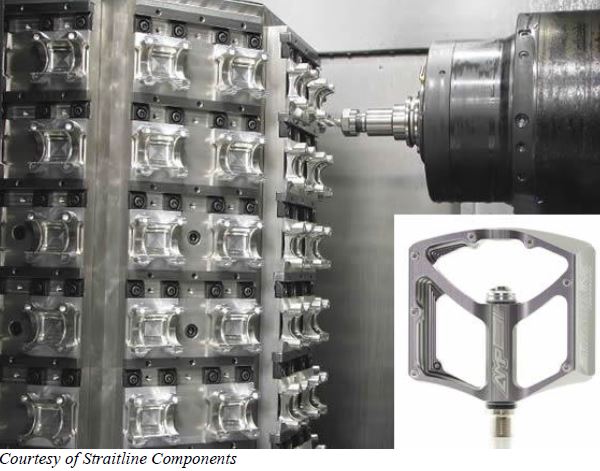
Cross-country and downhill cyclists appreciate having durable, lightweight parts while manufacturers of those parts, such as Straitline Components, like to reduce waste and boost productivity. To reduce manufacturing costs, the Sidney, British Columbia, company tries to minimize the amount of material required for effective workholding, but found throughput suffered because of its previous workholding method. The parts include pedals, stems, sprockets, rotary hydraulic couplings, bash rings and chain-guide devices—practically any machinable aftermarket bike part, noted D.J. Paulson, general manager for Straitline. In addition to producing its own brand of bike parts, Straitline is a job shop that serves an array of industries, from aerospace to oceanographic instrumentation. The company began producing its own bike parts to help ride out the business cycles of its customers. “We needed something to fill in the gaps without finding new machining customers, and we figured we could just create our own products,” Paulson said, noting that its bike part business represents 60 percent of Straitline’s work. When previously making aluminum bike parts, the shop was holding workpieces in double-lock vises mounted on tombstones, but found it couldn’t hold them tightly enough to optimize roughing parameters without causing workpiece slippage and out-of-tolerance parts. “We could hold onto more material, but that just meant manufacturing costs went up,” Paulson said. Figuring there must be a better way, the company sought alternatives and found Pitbull fixture clamps from Mitee-Bite Products LLC, Center Ossipee, N.H. The clamps provide a low gripping profile and high vertical and horizontal clamping forces, according to Mitee-Bite. For its aggressive stock-removal requirements, Straitline selected 0.750 “-wide clamps with a tool steel knife edge and maximum holding force of 3,600 lbs. It built a test fixture for the clamps and compared the clamp setup against the vise setup. “The clamps can apply a tremendous amount of down force because of the way they cam down onto the part,” Paulson said, noting that the clamps only hold 0.090 ” of stock using a standard ¼-20 cap screw. “We found we could push the Mitee-Bite setup as hard as we wanted without the parts shifting in the fixture.” Running a 1 “-dia. cutter at 14,000 rpm, Straitline can feed at about 250 ipm with a 3⁄8 ” DOC using the clamps vs. 100 ipm and 0.100 ” DOC using the vises, Paulson noted. “With the Mitee-Bites, we’re just flying through the material,” he said. For production applications using the clamps, Straitline made workholding fixture plates the same size as the tombstone faces. Dowel pins are used to locate the plates, which bolt onto the palletized tombstones, Paulson explained. The company uses an air tool to quickly tighten and loosen the clamp cap screws when placing parts on fixture plates and removing them.
When roughing bicycle components, such as an aluminum pedal (inset), on a tombstone, Straitline Components uses Pitbull fixture clamps from Mitee-Bite to hold as little as 0.090 ” of stock without the parts shifting in the fixture. Although the part loading/unloading process takes place while another tombstone’s worth of parts is being machined—and a different job can be on each face—quickly performing the process allows an operator to perform other tasks, such as packaging parts. “The pallet-change time is only 6 seconds, so there’s always something running in a machine,” Paulson said. In addition to being able to reduce cycle times by aggressively roughing the workpieces, the Pitbull arrangement enables Straitline to cut cycle times by fixturing more workpieces to a tombstone face, increasing from two parts per face to eight per face, for example, in one application on an eight-sided tombstone. That, in turn, means fewer tool changes because a tool runs through all parts on a tombstone before the next tool is applied. In addition, the machine experiences less wear and tear from the reduction in rapid movements. Paulson estimated that the decrease in noncut time from using high-density fixturing reduced cycle time by 25 percent—even with a machine that provides a 0.9-sec. tool change and 2,000-ipm rapids. “We wouldn’t be able to produce the number of parts per day without very dense fixturing unless we had more machines,” he said. Straitline employs the clamps on three milling machines. The shop performs some lights-out machining. When using vises, operators had to run machines on evenings and weekends to keep up with demand, whereas operators are now only needed to work 8-hour shifts Monday through Friday, according to Paulson. The unattended time at night and partly over the weekend makes up for the difference in part quantity, he noted. Sometimes a worker loads the tombstones, leaves at 5 o’clock at night, and the job runs until noon the next day, Paulson added. An exception might be when a tool breaks. Using an automatic probe, the company checks tools that are susceptible to breakage, such as those under 3⁄8 ” in diameter, after machining a face of parts. When a tool breaks, Paulson prefers stopping the machine to avoid the possibility of applying a new, redundant cutter to a part containing the broken tool and damaging another tool. But, using tool life history data and the correct parameters, stopping a machine during unattended operation is infrequent. “Usually, we go weeks or months without having anything break,” he said.
As seen in CUTTING TOOL ENGINEERING Magazine
12/10/15 Are you dense?

Many shops look to that old standby, a 6″, 2-jaw vise, for their machining centers’ workholding needs. True, vises are economical, simple to use and can grip most anything. They’re also a big waste of space. High-density workholding, on the other hand, makes the most of a machining center’s available real estate. By getting more parts on the table, nonproductive time that is normally lost to tool and pallet changes can be reduced. And, by increasing the number of parts per machine cycle, operators can do more than feed the machine with workpiece blanks. Of course, high-density workholding is not all sunshine and roses. Compared to a vise setup where you might lose a couple parts, one wrong offset or worn cutter when you’re running 50 workpieces can mean a high-density load of scrap, so you’d better have your ducks in a row before you push “cycle start.”
First, you need to build or buy a fixture. Building one can be straightforward. You’ll need a plate on which to mount the clamps. Opinions vary as to the best fixture material, but a chunk of Blanchard-ground, low-carbon steel or even some MIC 6 aluminum will do. If you’re looking for quick-change, it doesn’t take a rocket scientist to design something using off-the-shelf tooling components. And if time’s short but money’s long, buy one ready to go from one of the many companies specializing in this sort of thing. You’ll be swapping out high- density fixtures faster than a sandwich run to Subway. Next come the compact clamps. A number of clamp manufacturers are out there, including Mitee-Bite Products LLC, Center Ossipee, N.H., whose cam-action clamps began appearing in shops around the time Ronald Reagan first told Mr. Gorbachev to “tear down that wall.” Cam-action clamps use an offset-head, hardened-steel cap screw and a hexagonal washer to push a workpiece against a stationary rail or pin. These are the original workhorses of the Mitee-Bite line. Knife-edge clamps function in a similar manner, but use a hardened clamping element that digs into rough surfaces like castings. After you’ve selected the right clamps, dimensional data on them is available from the Mitee-Bite catalog or on its Web site. Registered users can also download CAD files. From there, it’s a matter of laying out the workpieces on the fixture plate and surrounding them with the appropriate number of clamps and locating surfaces. Many of the Mitee-Bite clamps require nothing more than a tapped hole to secure them, while others require dowel pins or some machining to accommodate the workpiece. Most CAD systems will make short work of this step. And you might need fewer clamps than you think—some of these bad boys boast 10,000 ft./lbs. of torque, more holding power than the first kiss at your high-school prom.
From there, it’s out to the toolroom for machining and assembly of the completed fixture. Someone who has built high-density fixtures and lived to tell about it is Ernie Clark, programmer and designer at Hodge Tool Co. Inc., a shop located in Lancaster, Pa. Hodge specializes in high-speed machining of aluminum and copper components for companies such as Radio Frequency Systems and Ericsson. It also builds firearm components, including Picatinny rails, a military-spec mounting bracket used on assault rifles to attach accessories, such as flashlights, laser pointers and night-vision devices. Hodge Tool has been buying Mitee-Bite workholding for more than 14 years, said Ed D’Aiuto, sales manager for distributor Tucker Tool Co., Mechanicsburg, Pa. When Clark needed to fixture flip sights for a firearms customer, he turned to OK-Vise clamps, a low-profile, pull-down clamp, the largest of which generates a whopping 33,000 ft./lbs. of force.
According to Mitee-Bite, this makes them especially suitable for the multidirectional cutting forces seen with 3-D machining. Clark utilized a dual-acting OK-Vise clamp in the middle of the fixture, together with fixed-jaw TalonGrips on each side, which bite into the bottom 0.060 ” of the workpiece blank. “That way, we can grip two parts with a single clamping,” Clark said.
The result was a fixture that let Hodge Tool machine both sides of 40 work-pieces in a footprint not much larger than a 6″ machinist’s vise. The shop has dozens of similar fixtures, used primarily on a pair of Mori Seiki, 12- pallet-pool horizontal machining cells. “For new fixtures, we design it all in Mastercam and then simulate the whole thing so we can see exactly how it will work,” Clark said. “Then, we take a big steel block and bolt it to a tombstone. From there, we machine out the pockets and mounting holes.
Then, we put the clamps on and load up the parts.” Mitee-Bite General Manager Dave Bishop noted examples like those just described are just the tip of the high- density iceberg. Some of the key factors are part size and weight, machining forces and the permitted amount of sacrificial material. “Our Pitbull clamps, as well as the TalonGrip, dig into the workpiece,” he said. “This allows aggressive machining while holding onto less than 0.100″ of material, but you do need to consider the ‘puppy bites’ in your part process,” small clamp marks that will need to be machined away in a subsequent operation. Bishop noted that while high-density fixtures are not rocket science, care should still be taken when implementing them and recommends test fixtures for difficult applications. “To support that effort,” he said, “we provide samples and technical advice for shops to prove out designs prior to building production fixtures. “At the end of the day, placing more parts on the table lowers labor costs and increases capacity,” Bishop continued. “That, in turn, allows companies to quote more jobs, gain more customers and grow.”
About the Author: Kip Hanson is a contributing editor for CTE. Contact him at (520) 548-7328 or [email protected].
Mitee-Bite Products Inc. and TE-CO Announce Partnership

Mitee Bite Products Inc. and TE-CO officially announce their partnership in serving the industrial metalworking industry. Both companies have built substantial reputations for quality workholding products & world class customer service.
Mitee Bite Products Inc. (Ossipee, NH) is a leading manufacturer of workholding systems and components for small to medium workpieces. Mitee Bite Products Inc. will continue to operate from its manufacturing facility in Ossipee, NH. Its products will continue to be distributed internationally through a comprehensive distribution network.
TE-CO (Union, OH) is a leading manufacturer of workholding devices and components, including jig & fixture components & precision vises.
This strategic partnership will provide a complete workholding solution for the metalworking industry from small to large workpieces. The two companies will mutually benefit from their combined domestic & international distribution network and complementary product lines. Mitee Bite and TE-CO will continue to operate as individual companies utilizing each others strengths.
For More Information Contact:
Mitee-Bite Products Inc.
Center Ossipee, NH 03814
800-543-3580
[email protected]
OK-Vise® Helps Keep Smith & Wesson On Target
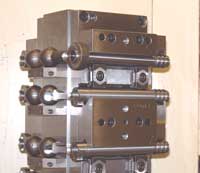 Smith & Wesson located in Springfield, MA is well known the world over, for it’s high quality gun manufacturing. It’s facility is over 500,000 square feet and they employee in excess of 600 people. Perhaps less known is the Specialty Services division of Smith & Wesson, which does various types of contract machining.
Smith & Wesson located in Springfield, MA is well known the world over, for it’s high quality gun manufacturing. It’s facility is over 500,000 square feet and they employee in excess of 600 people. Perhaps less known is the Specialty Services division of Smith & Wesson, which does various types of contract machining.
 Recently the Specialty Services Division was running jobs for Weatherby Rifle and had some applications of holding radius shaped parts on work cubes for several different work pieces. The difficulty of the set up was to clamp the pieces from the side, so the clamp would not be in the way and not take up too much valuable space. The engineer contacted their distributor, Kenneth Crosby Inc., who realized that because the parts were located in a rest block with a V, that the clamps would need to be wedge clamps with a fair amount of travel. This way the clamp could retract enough to exchange work pieces easily. OK-Vise® clamps by Mitee-Bite Products was chosen because of their compact size and strong holding force of over 6000 lbs. These clamps are self centering which was important to allow equal clamping force on each part. The hardened and ground clamps have a range of expansion of up to .280 which made part exchange easy. One of the jobs was clamping forgings before machining so the serrated edges provided extra grip for better rigidity.
Recently the Specialty Services Division was running jobs for Weatherby Rifle and had some applications of holding radius shaped parts on work cubes for several different work pieces. The difficulty of the set up was to clamp the pieces from the side, so the clamp would not be in the way and not take up too much valuable space. The engineer contacted their distributor, Kenneth Crosby Inc., who realized that because the parts were located in a rest block with a V, that the clamps would need to be wedge clamps with a fair amount of travel. This way the clamp could retract enough to exchange work pieces easily. OK-Vise® clamps by Mitee-Bite Products was chosen because of their compact size and strong holding force of over 6000 lbs. These clamps are self centering which was important to allow equal clamping force on each part. The hardened and ground clamps have a range of expansion of up to .280 which made part exchange easy. One of the jobs was clamping forgings before machining so the serrated edges provided extra grip for better rigidity.
 These jobs have been running for some time now without any clamping problems. Steve Wasielewski, Manuacturing Engineer, is pleased with the performance of the OK-Vise® clamps and states that the Speciality Services Division of Smith & Wesson has used these clamps on several other applications with the same results.
These jobs have been running for some time now without any clamping problems. Steve Wasielewski, Manuacturing Engineer, is pleased with the performance of the OK-Vise® clamps and states that the Speciality Services Division of Smith & Wesson has used these clamps on several other applications with the same results.
For more information contact Mitee-Bite Products at 800-543-3580.
CT Shop Uses Mitee-Bite® Clamps for Close Tolerances, Difficult Holds
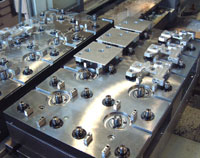 Quality Design & Mfg. of Oxford, CT has been in the machining business for over 20 years. The owners, Marty and Sue Martovich have recently developed a joint venture with Richard Grano. With the new management and change of direction, QDM moved to a larger more modern high tech facility to accommodate additional machinery acquired for larger production jobs.
Quality Design & Mfg. of Oxford, CT has been in the machining business for over 20 years. The owners, Marty and Sue Martovich have recently developed a joint venture with Richard Grano. With the new management and change of direction, QDM moved to a larger more modern high tech facility to accommodate additional machinery acquired for larger production jobs.
One of these production jobs is an assembly for the medical industry. This assembly begins with machined aluminum housing that is difficult to hold because of the amount of material that needs to be removed. Marty’s regular distributor, American Tool in Cromwell, CT recommended the Pitbull clamps by Mitee-Bite Products because of the aggressive stock removal involved. The size Pitbull clamp used has a 8-32 screw and grips the part by only .100 from the fixture surface, which was ideal for this application. The knife edge version bites directly in the material virtually eliminating ripping the part out by cutter force.
The first operation required a 1 inch roughing end mill running at 10,000 RPM with feeds in excess of 100 inches per minute. The last portion of this operation was to finish the size of several close tolerance bores including one that is elongated by .030.
The second operation was to locate and clamp from the close tolerance bores to enable completing the part in only 2 setups. Mitee-Bite’s ID Xpansion clamps were used for this application. Made of mild steel they can be machined to match the bores. One clamp was machined to match the elongated bore to prevent distortion. The part was then finished machined as in the photo. The photo shows extra ID Xpansion clamps mounted in the fixture.
These are to hold the mirror image part on the same fixture. The end result is odd-shaped parts produced in a timely manner without part movement or vibration because of ridged fixtures. Marty states that Quality Design & Mfg has several other fixtures using Pitbull clamps because of their strong holding force and ultra-low profile.
For more information contact Mitee-Bite Products at 800-543-3580.
Mitee-Bite Products OK-VISE® Clamp – Small in Size, high in clamping force
 The OK-VISE® clamp is a wedge activated clamp. As the screw is tightened, the clamp expands and pulls the workpiece down at the same time. Small in size and high in clamping force, this low profile clamp is available in many different sizes.
The OK-VISE® clamp is a wedge activated clamp. As the screw is tightened, the clamp expands and pulls the workpiece down at the same time. Small in size and high in clamping force, this low profile clamp is available in many different sizes.
The OK-VISE® clamp is precision ground on all moving surfaces to ensure accuracy and ease of adjustment. The heat treated clamping jaws are serrated for better grip. The design of the clamp is excellent for multiple use on pallets and horizontal machines. The heat treated jaws are excellent for clamping rough cut stock and castings. Some clamp models are available with softer jaws for machining to fit special applications such as round pieces or making V jaws. These clamps use mounting screws from 5/16 to 5/8 diameter.
For More Information Contact:
Mitee-Bite Products Inc.
Center Ossipee, NH 03814
800-543-3580
[email protected]
Micro Clamps for Micro Machining
 Mitee-Bite Products specializes in low profile edge clamps in several different styles and sizes for jigs and fixtures, including a range for micro machining. The miniature clamps are available in cam action design, wedge design and Pitbull® design which bites in and pulls down. Some of these clamps are less than 1/8 inch high and 3/8 square allowing for dense fixture loading of miniature work pieces. Mitee-Bite’s clamps can be operated manually and the wedge and Pitbull® clamps can be activated using a hex type torque driver for quicker loading and unloading. The photos show density loading and the different type of clamps.
Mitee-Bite Products specializes in low profile edge clamps in several different styles and sizes for jigs and fixtures, including a range for micro machining. The miniature clamps are available in cam action design, wedge design and Pitbull® design which bites in and pulls down. Some of these clamps are less than 1/8 inch high and 3/8 square allowing for dense fixture loading of miniature work pieces. Mitee-Bite’s clamps can be operated manually and the wedge and Pitbull® clamps can be activated using a hex type torque driver for quicker loading and unloading. The photos show density loading and the different type of clamps.
For More Information Contact:
Mitee-Bite Products Inc.
Center Ossipee, NH 03814
800-543-3580
[email protected]

